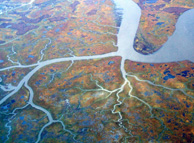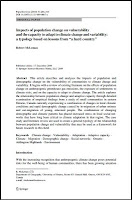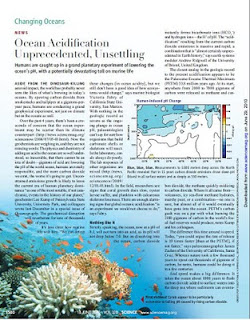Showing posts from category Reading Radar.
-
Assessing Our Impact on the World’s Rivers
› In a special “Rivers in Crisis” issue of Nature, the lead article, “Global Threats to Human Water Security and River Biodiversity,” presents damning evidence that manipulation of river systems — through the construction of canals, levees, hydroelectric projects, and other infrastructure — has caused serious and lasting biological damage to watersheds throughout both the developing and developed worlds. The authors (all 11 of them!) report that key rivers have become shadows of their former selves in terms of the amount of aquatic life they can support. Without drastically improved stewardship of waterways, “we are pushing these river systems toward catastrophe,” warns Peter McIntyre, an article co-author.
In a special “Rivers in Crisis” issue of Nature, the lead article, “Global Threats to Human Water Security and River Biodiversity,” presents damning evidence that manipulation of river systems — through the construction of canals, levees, hydroelectric projects, and other infrastructure — has caused serious and lasting biological damage to watersheds throughout both the developing and developed worlds. The authors (all 11 of them!) report that key rivers have become shadows of their former selves in terms of the amount of aquatic life they can support. Without drastically improved stewardship of waterways, “we are pushing these river systems toward catastrophe,” warns Peter McIntyre, an article co-author. The human impact on the world’s river systems will be hard to reverse, says Margaret Palmer, author of a second Nature article on freshwater biodiversity loss, “Beyond Infrastructure.” Human-induced changes to watersheds affect local hydrology at a fundamental level, she contends, weakening rivers’ ability to deliver crucial “ecological goods and services” — such as clean water and nutrient-rich sediment loads — that help maintain the health of local environments and the human populations that depend on them. To fully understand the scope of the problem, Palmer says more research is needed to explore the linkages between biodiversity levels and “ecosystem services” that healthy rivers provide.
The human impact on the world’s river systems will be hard to reverse, says Margaret Palmer, author of a second Nature article on freshwater biodiversity loss, “Beyond Infrastructure.” Human-induced changes to watersheds affect local hydrology at a fundamental level, she contends, weakening rivers’ ability to deliver crucial “ecological goods and services” — such as clean water and nutrient-rich sediment loads — that help maintain the health of local environments and the human populations that depend on them. To fully understand the scope of the problem, Palmer says more research is needed to explore the linkages between biodiversity levels and “ecosystem services” that healthy rivers provide. -
The Effects of Climate Change on Water in South Africa and Tibet
›From Hydrology and Earth System Sciences Discussions, “Uncertainty in Water Resources Availability in the Okavango River Basin as a Result of Climate Change,” by D.A. Hughes, D.G. Kingston, and M.C. Todd, explores the effects of a two degrees Celsius global warming scenario on the Okavango River Basin, a “major natural resource for human water supply” shared by Angola, Botswana, and Namibia. The authors conclude that “there is a relatively high probability of large changes to the extent and duration of inundation within the delta wetland system during the 21st century,” and recommend multi-annual to decadal ecological assessments of assumed low rainfall and river flow to guide integrated river basin water management plans.
“Climate Change and Environmental Degradation in Tibet: Implications for Environmental Security in South Asia,” by P.K. Gautam in Strategic Analysis, argues for Tibet’s designation as a regional – if not global – common, for the sake of South Asian security. Tibet faces significant risk of ecological degradation due to climate change. Further degradation of its water supply would significantly affect India, China, and Southeast Asia. According to Gautam, establishing Tibetan autonomy would ensure greater ecological preservation, contrary to the rapid development model pursued by China. -
Climate Change Adaptation and Mitigation in the Agricultural Sector
›“Climate Change and China’s Agricultural Sector: An Overview of Impacts, Adaptation and Mitigation” from the International Centre for Trade and Sustainable Development (ICTSD) explores mitigation and adaptation strategies to avoid the worst effects of climate change in China’s farming sector. The authors, Jinxia Wang, Jikun Huang and Scott Rozelle, point out that, although often overlooked in favor of the industrial sector, a disproportionate amount (greater than 15 percent) of China’s greenhouse gas emissions come from agriculture. Challenges include over-fertilization, high methane levels, water pollution, and water scarcity. Wang, Huan, and Rozelle predict that trade “can and should be used to help China mitigate the impacts of climate change” and programs promoting better calibration of fertilizer dosages and “conservation tilling” practices will help farmers reduce emissions.
Also from ICTSD comes another study on climate adaptation and mitigation, this time focusing on the developing world. Globally, agriculture accounts for only 4 percent of GDP but according to the IPCC it also accounts for more than 25 percent of greenhouse gas emissions, making climate adaptation and mitigation in the sector particularly important. “Agricultural Technologies for Climate Change Mitigation and Adaptation in Developing Countries: Policy Options for Innovation and Technology Diffusion” by Travis Lybbert and Daniel Sumner examines some of the more promising innovations that may help those countries most vulnerable to climate change to cope with and minimize risk. The authors suggest that most policies that target economic development and poverty reduction will also naturally lead to improvements in agriculture, accordingly most of their recommendations center around improving market efficiency, communication of technologies and best practices, and investment in research and development. -
Local Case Studies of Population-Environment Connections
›“The role of intergenerational transfers, land, and education in fertility transition in rural Kenya: the case of Nyeri district” in Population & Environment by Karina M. Shreffler and F. Nii-Amoo Dodoo, explores the reasons for a dramatic and unexpected decline in fertility in rural Kenya. In one province, total fertility rate (TFR) declined from 8.4 to 3.7, from 1978 to 1998. The study found numerous contributing factors for this decline, which occurred more quickly and earlier than demographers expected, but land productivity seemed to be the primary motivator. A growing population and the tradition of dividing family land among sons made continuing to have large families unrealistic for these Kenyan families. “Family planning is, therefore, not the primary causal explanation for limiting the number of children, but rather serves to help families attain their ideal family sizes,” the authors conclude. Also in Population & Environment, “Impacts of population change on vulnerability and the capacity to adapt to climate change and variability: a typology based on lessons from ‘a hard country,’” by Robert McLeman, explores the potential for human communities to adapt to climate change. The article centers on a region in Ontario that is experiencing changes in both local climatic conditions and demographics. The study finds that demographic change can have both an adverse and positive effect on the ability of a community to successfully adapt to climate change and highlights the importance of social networks and social capital to a community’s resilience or vulnerability. McLeman also presents a new typology that he hopes will “serve the purpose of drawing greater attention to the degree to which adaptive capacity is responsive to population and demographic change.”
Also in Population & Environment, “Impacts of population change on vulnerability and the capacity to adapt to climate change and variability: a typology based on lessons from ‘a hard country,’” by Robert McLeman, explores the potential for human communities to adapt to climate change. The article centers on a region in Ontario that is experiencing changes in both local climatic conditions and demographics. The study finds that demographic change can have both an adverse and positive effect on the ability of a community to successfully adapt to climate change and highlights the importance of social networks and social capital to a community’s resilience or vulnerability. McLeman also presents a new typology that he hopes will “serve the purpose of drawing greater attention to the degree to which adaptive capacity is responsive to population and demographic change.”
SpringerLink offers free access to both these articles through August 15. -
Rough Waters Ahead: Our Changing Ocean
›From the ocean-themed June issue of Science comes “Sea-Level Rise and Its Impact on Coastal Zones“, by Robert J. Nicholls and Anny Cazenave. While sea-level rise will “almost certainly accelerate through the 21st century and beyond because of global warming,” Nicholls and Cazenave state that its magnitude remains uncertain. Small islands as well as the coasts of Africa, India, Southeast Asia, and China are identified as vulnerable areas because of their “dense populations, low elevations, appreciable rates of subsidence, and/or inadequate adaptive capacity.” Nicholls and Cazenave call for more research and analysis into adaptation, which “remains a major uncertainty.” “Ocean Acidification: Unprecedented, Unsettling,” by Richard A. Kerr, also appears in the June issue of Science. “Humans are caught up in a grand planetary experiment of lowering the ocean’s pH, with a potentially devastating toll on marine life,” begins Kerr, who aims to convince climate change-focused readers to also look at the world’s oceans. Rising pH levels, caused by ocean waters absorbing higher levels of carbon dioxide, are damaging shelled creatures, coral, and the organisms that rely on them for sustenance (which includes people, especially coastal populations dependent on the oceans for protein). An Australian survey recently found that calcification in the Great Barrier Reef had declined 14.2 percent since 1990 – a severe decline that has not been matched in the last 400 years. Kerr claims that “aside from the dinosaur-killing asteroid impact, the world has probably never seen the likes of what’s brewing in today’s oceans.”
“Ocean Acidification: Unprecedented, Unsettling,” by Richard A. Kerr, also appears in the June issue of Science. “Humans are caught up in a grand planetary experiment of lowering the ocean’s pH, with a potentially devastating toll on marine life,” begins Kerr, who aims to convince climate change-focused readers to also look at the world’s oceans. Rising pH levels, caused by ocean waters absorbing higher levels of carbon dioxide, are damaging shelled creatures, coral, and the organisms that rely on them for sustenance (which includes people, especially coastal populations dependent on the oceans for protein). An Australian survey recently found that calcification in the Great Barrier Reef had declined 14.2 percent since 1990 – a severe decline that has not been matched in the last 400 years. Kerr claims that “aside from the dinosaur-killing asteroid impact, the world has probably never seen the likes of what’s brewing in today’s oceans.” -
Sustainable Development
›Are Women the Key to Sustainable Development?, by Candice Stevens and appearing in Boston University’s Sustainable Development Insights series, asks whether gender-conscious development strategies are the missing link in the three pillars–social, economic, and environmental–of sustainable development. She points out that “An increasing number of studies indicate that gender inequalities are extracting high economic costs and leading to social inequities and environmental degradation around the world.” In the policy world gender-conscious initiatives are often more effective as well. “United Nations and World Bank studies show that focusing on women in development assistance and poverty reduction strategies leads to faster economic growth than ‘gender neutral’ approaches.” Stevens finds that achieving greater gender parity may be the key to better governance, increased growth, and a safer environment. The Role of Cities in Sustainable Development, by David Satherwaite and also appearing in Boston University’s Sustainable Development Insights series, argues that traditional depictions of cities as dirty and unsustainable are inaccurate. Instead, “…with the right innovation and incentives in place, cities can allow high living standards to be combined with resource consumption that is much lower than the norm in most cities today,” he finds. Satherwaite contends that high-density living arrangements can reduce per capita energy consumption, transportation emissions, and costs of public service provisions like hospitals and schools. However, he warns that none of these potential advantages are guaranteed, and city planners must utilize effective local governance in order to make cities safe, clean, and sustainable.
The Role of Cities in Sustainable Development, by David Satherwaite and also appearing in Boston University’s Sustainable Development Insights series, argues that traditional depictions of cities as dirty and unsustainable are inaccurate. Instead, “…with the right innovation and incentives in place, cities can allow high living standards to be combined with resource consumption that is much lower than the norm in most cities today,” he finds. Satherwaite contends that high-density living arrangements can reduce per capita energy consumption, transportation emissions, and costs of public service provisions like hospitals and schools. However, he warns that none of these potential advantages are guaranteed, and city planners must utilize effective local governance in order to make cities safe, clean, and sustainable. -
Shrinking Desired Family Size and Declining Child Mortality
›Desired Number of Children: 2000-2008, a report prepared by Charles Westoff of Princeton University for USAID, reviews family size preferences in 60 countries. Taking its data from a series of Demographic and Health Surveys (DHS), the report found that “the number of children desired is declining in most of the developing world.” The noted exception is western and middle sub-Saharan Africa where, in some countries, 6.0 children remains the desired number. The report found that desire for smaller family sizes, rather than a reduction of unwanted births, was the primary factor behind the declining Total Fertility Rates (TFR) exhibited in most of the countries studied. It noted that men’s preference is close to, but larger than, that of women, and that preference sizes were declining even among women without formal education. The report concluded that preferred family size broadly depended upon “child mortality, Muslim affiliation, women’s education and empowerment, and exposure to the mass media.” In an article appearing in the latest The Lancet, researchers from University of Washington and University of Brisbane found that global child mortality has declined 35 percent since 1990, outpacing initial forecasts. Neonatal, Postneonatal, Childhood, and Under-5 Mortality for 187 Countries, 1970—2010: A Systematic Analysis of Progress Towards Millennium Development Goal 4 found that 31 developing countries are on track to achieve Millennium Development Goal 4 and that in certain regions, including sub-Saharan Africa, declines in mortality are actually accelerating. The report concludes that the positive trends in child mortality “deserve attention and might need enhanced policy attention and resources.”
In an article appearing in the latest The Lancet, researchers from University of Washington and University of Brisbane found that global child mortality has declined 35 percent since 1990, outpacing initial forecasts. Neonatal, Postneonatal, Childhood, and Under-5 Mortality for 187 Countries, 1970—2010: A Systematic Analysis of Progress Towards Millennium Development Goal 4 found that 31 developing countries are on track to achieve Millennium Development Goal 4 and that in certain regions, including sub-Saharan Africa, declines in mortality are actually accelerating. The report concludes that the positive trends in child mortality “deserve attention and might need enhanced policy attention and resources.” -
21st Century Water
›The Economist published this week For Want of a Drink, its special report on water. The report, a compilation of 11 articles, is a mix of surveys of global management strategies, health impacts, and economic considerations on the one hand, and deeper looks into specific practices in Singapore, India, and China on the other. Most interesting for New Security Beat readers is the article “To the Last Drop: How to Avoid Water Wars.” The article states there have been “no true water wars,” but goes on to question whether the pressures of climate change and population growth could generate different outcomes in the future. While the challenges laid out are manifold, the article concludes that potential for cooperation is equally present. “The secret is to look for benefits and then try to share them. If that is done, water can bring competitors together.” Global Change: Impacts on Water and Food Security, published by IFPRI in collaboration with CGIAR and the Third World Centre for Water Management, is an anthology of focused articles studying “the interplay between globalization, water management, and food security.” While heavily focused on trade and finance, the articles span the spectrum of food and water challenges, from biofuels to the global fish trade. Overall, the book finds that “global change provides more opportunities than challenges,” but taking advantage of globalization’s opportunities demands “comprehensive water and food policy reforms.”
Global Change: Impacts on Water and Food Security, published by IFPRI in collaboration with CGIAR and the Third World Centre for Water Management, is an anthology of focused articles studying “the interplay between globalization, water management, and food security.” While heavily focused on trade and finance, the articles span the spectrum of food and water challenges, from biofuels to the global fish trade. Overall, the book finds that “global change provides more opportunities than challenges,” but taking advantage of globalization’s opportunities demands “comprehensive water and food policy reforms.”




















